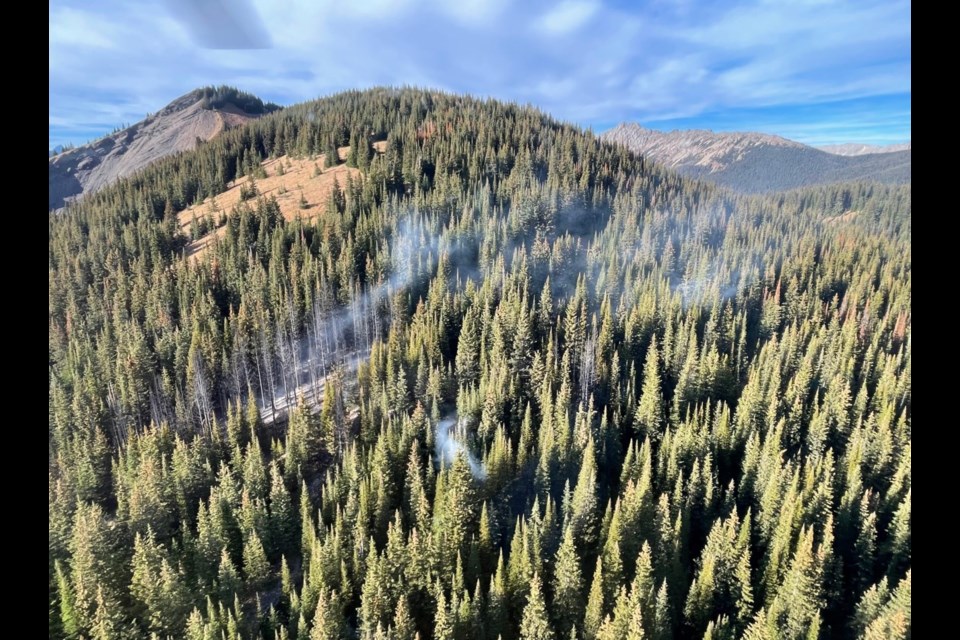KANANASKIS COUNTRY – Kananaskis Improvement District (KID) is reviewing its land use order to develop recommendations aimed at strengthening the municipality’s wildfire protection and preparedness.
With a review of FireSmart regulations in the 2009 land use order will come an update to KID’s wildfire mitigation strategy – last updated in 2015 – to evaluate future efforts and funding to reduce the threat of wildfire in KID.
“We applied for three different projects, one of which includes updates to the land use order and the language around FireSmart and the FireSmart materials because the land use order was originally developed around 2009 and there’s a new rating for some of the materials and new materials that are available,” said municipal advisor Julia Millen, during a council meeting last week.
“We’ve applied and the work is underway with both a consultant as well as having some independent legal review to make sure it meets all those requirements that we have.”
The Fire Resource Improvement Association of Alberta (FRIAA) approved $78,000 in grant funding for the municipality to assist with the projects after it applied earlier this year. The last project will allow for the completion of fuel break maintenance at Camp Chief Hector YMCA.
A staff report noted nearly 23 hectares of the fuel break at the camp was maintained in 2022-23 “until grant funds were depleted,” leaving a remaining 3.85 hectares unfinished.
About 27 hectares of land around the south boundary of the camp is included under KID’s FireSmart vegetation management. With funding from FRIAA, the fuel break is now expected to be finished in December.
About 275 hectares of FireSmart vegetation management has been completed since 1994 by KID, Alberta Parks, and Alberta Wildfire Management, based on recommendations in Wildfire Mitigation Strategies for KID, noted KID council chair Melanie Gnyp.
“Some areas have been recently maintained while others have not,” said Gnyp in an email.
Across its management areas, KID, working with partner agencies, reduces forest fuels through controlled burns, thinning and removing vegetation. Structural fire suppression is the responsibility of KID and wildfire management is the responsibility of the provincial government.
The Kananaskis Country vegetation management strategy, approved in 2008, and the Evan Thomas vegetation management strategy address vegetation management at the landscape level surrounding developed areas, while the KID wildfire mitigation strategy focuses on prevention at the building and community levels to reduce wildfire spread and improve structure survival.
KID’s FireSmart management area covers 297.3 hectares and includes development areas such as the west side of the Canmore Nordic Centre, Lower Kananaskis Lake cabin subdivision, Kananaskis Village, William Watson Lodge, University of Calgary Field Station and Camp Horizon.
Based on the progress of vegetation management on the lands, which are primarily provincial Crown lands, revising the plan is a “cost-effective way to provide focused priorities for KID to reduce the threat of wildfire to life and property,” stated the staff report.
The municipality’s wildfire mitigation strategy, prepared by Canmore-based Montane Forest Management Ltd. more than eight years ago, included an additional 137.2 hectares of proposed vegetation management based on FireSmart hazard and risk values.
Sorted into two priority groups, additional management areas to consider included the Peter Lougheed Provincial Park Visitor Centre and Sheep River Administration Centre. Additional land was also recommended for the Nordic Centre, Kananaskis Golf Course Subdivision, and Tim Horton Children’s Ranch, among others.
The Kananaskis Country Golf Course, Nakiska Ski Resort, and various other developments were listed as of lesser priority but still recommended vegetation management.
According to the wildfire mitigation plan, KID consists mainly of flammable pine and spruce fuels with patches of mixed wood and deciduous fuels along its eastern edge.
Fire incidence data tracked by Alberta Environment and Sustainable Resource Development indicates that 539 wildfires were discovered within KID between 2005-2014, with 94 per cent human-caused and six per cent caused by lightning.
“The majority of the human-caused wildfires were abandoned campfires in the major recreation corridors and were contained at less than 0.1 hectares,” noted the wildfire mitigation plan. “There were also 10 wildfires caused by powerlines from 2005 to 2011.”
Despite efforts to decrease structure and site hazard scores with fire-rated materials and to reduce wildland fuels in higher-priority zones, many developments were still rated as having high or extreme hazard ratings due to several factors including a lack of clearance to combustible wildland fuels, combustible materials being within 10 metres of a structure, and a need to extend vegetation management further.
Of the 46 development areas identified in 2015, all but 11 had a FireSmart structure and site hazard rating of extreme. Two were rated as high.
The report highlighted the risk levels to structures and sites are primarily attributed to flammable exterior building materials, uncovered undersides of decks and porches, and insufficient management of vegetation.
Area hazards, categorized as between 30-100 metres of development, had 20 developments rated as extreme risk.
Updates to KID’s land use order will be reviewed by early 2024 and will examine FireSmart regulations and recommendations for enhancing current FireSmart development standards, in alignment with FireSmart Canada and the NRC National Guide for Wildland Urban Interface, with the assistance of consultants.
Results from consultant field work done on the wildfire mitigation strategy this fall will be compiled in early 2024 with an update expected after.
The Local Journalism Initiative is funded by the Government of Canada. The position covers Îyârhe (Stoney) Nakoda First Nation and Kananaskis Country.




